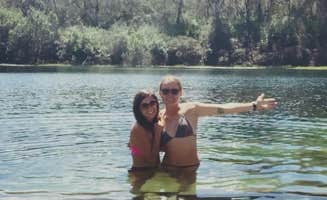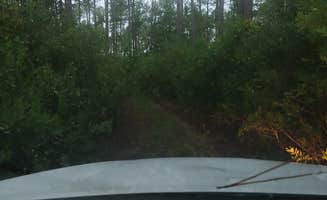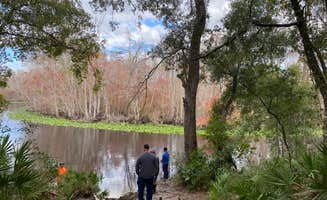Primitive camping near Umatilla, Florida centers on the Ocala National Forest, which encompasses over 380,000 acres and contains numerous pine scrub forests, spring-fed lakes, and river access points. Sand pine scrub habitat dominates much of the terrain, creating challenging driving conditions that worsen significantly during Florida's rainy season from June through September. Winter temperatures typically range from 45-70°F, making December through March the most comfortable camping season.
What to do
Paddling access points: The Ocklawaha River at Davenport Landing provides opportunities for kayaking through lily pad-covered waters. "Located a hefty trek down a winding gravel road west of Route 19... there's an amazing little access point here to the Ocklawaha river that runs through this neck of the woods – which used to be a riverboat stop where steamboats would stop to fuel or disembark enroute to Silver Springs," notes Stuart K.
Fishing spots: Local anglers report productive fishing in the rivers and lakes surrounding Umatilla. At St. Johns River Dispersed Spot, campers can access prime fishing areas directly from their campsite. "Right next to the river and the trees open up so you get a great view of the stars," reports Mike D.
Historical exploration: The Davenport Landing Trail offers a 1.2-mile interpretive hike to a former steamboat landing with Civil War historical significance. According to one camper, "If you have an explorer's mindset, you'll be richly rewarded here as there is a small gravesite from the Civil War that you can find along with middens along the Ocklawaha River hiding traces of the Timucuan Indians that once populated this area."
What campers like
Isolation from crowds: The challenging access routes create naturally secluded camping environments. At Freak Creek Dispersed Camping, Adamm A. appreciates that "It's super secluded and quiet. Depending when you stay there's at times people who show up to party and then leave."
Natural shade: The mature tree canopy provides essential protection from Florida's intense sun. Magnolia trees feature prominently at certain sites, creating distinctive camping environments. "You'll be greeted by a dozen or so medium-sized Magnolias that blot out the sun's rays and cast an unusually spooky shadow on this area, made even more dramatic by all of the Spanish moss falling from the tree limbs," describes one visitor.
Wildlife viewing: Beyond the standard Florida wildlife, campers report occasional rare sightings. A Freak Creek visitor noted, "I talked to another person that use to go out there and said she has seen a panther. I've yet to see anything."
What you should know
Vehicle requirements: High-clearance four-wheel drive vehicles are essential for accessing most dispersed camping areas. At Trout Lake Primitive Sites, one reviewer cautions: "Main road entry is packed dirt; smaller access road to sites is two-track about 1/4 mile through woods — very narrow tree clearance. 4WD recommended."
Communications limitations: Cell service throughout the forest ranges from unreliable to nonexistent. "Poor cell service even with booster. Plan on returning after antenna upgrade," reports one Trout Lake camper.
Site maintenance issues: Some locations suffer from improper use by long-term occupants. "I would not come back here again. There were obviously some long term residents that had set up shack here, and while they did not make the campground feel unsafe, they were trashing up the place," reports Sam S.
Recovery equipment: Sand and mud create significant vehicle mobility challenges. One Freak Creek visitor warns, "If you don't have 4wd and recovery gear I wouldn't risk it. There is a nice creek area where you can swim and or fish if you have the right equipment to get back there it can be fun, but if you don't you will be stuck until some one comes by."
Tips for camping with families
Swimming spots: The natural water features offer cooling recreation opportunities but require proper precautions. "The campground is overgrown, and not many ppl visit due to not being able to get back. If you don't have 4wd and recovery gear I wouldn't risk it. There is a nice creek area where you can swim and or fish," notes a Freak Creek camper.
Wildlife awareness: Families should maintain proper food storage and wildlife awareness. Blue Sink campers may encounter typical Florida wildlife, but one camper describes it as the "Most beautiful place to stumble upon. You may need ATV or creative backpacking to get there now. The Forestry Service recently chopped down trees and covered the easy access roads."
Weather planning: Florida's frequent afternoon thunderstorms necessitate proper shelter and equipment. During summer months, temperatures regularly exceed 90°F with high humidity, making spring and fall more comfortable for family camping.
Tips from RVers
Vehicle width limitations: Trees create narrow passages unsuitable for standard RVs. "Very narrow trails but really easy access, you will leave with some new pinstripes," warns Joe P. about Trout Lake Primitive Sites.
Alternative access methods: Some locations better suit ATV access than traditional vehicle camping. For Blue Sink, Destiny R. advises, "You may need ATV or creative backpacking to get there now. The Forestry Service recently chopped down trees and covered the easy access roads."
Length restrictions: Most dispersed sites cannot accommodate large trailers or motorhomes. "Pulled in around 9:30 pm. Big open spot. Last 100 yards driving back in were very bumpy but no problem with our van. Not sure about a larger RV," notes David P. about primitive camping at Davenport Landing.




